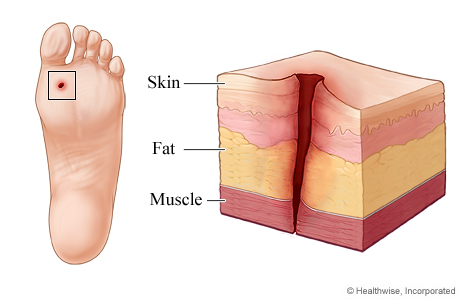Jump to
Puncture Wound

A puncture wound is a forceful injury caused by a sharp, pointed object that penetrates the skin. A puncture wound is usually narrower and deeper than a cut or scrape.
How can you care for puncture wounds?
- Keep the wound dry for the first 24 to 48 hours. After this, you can shower if your doctor okays it. Pat the wound dry.
- Don't soak the wound, such as in a bathtub. Your doctor will tell you when it's safe to get the wound wet.
- If your doctor told you how to care for your wound, follow your doctor's instructions. If you did not get instructions, follow this general advice:
- After the first 24 to 48 hours, wash the wound with clean water 2 times a day. Don't use hydrogen peroxide or alcohol, which can slow healing.
- You may cover the wound with a thin layer of petroleum jelly, such as Vaseline, and a nonstick bandage.
- Apply more petroleum jelly and replace the bandage as needed.
- Prop up the sore area on pillows anytime you sit or lie down during the next 3 days. Try to keep it above the level of your heart. This helps reduce swelling.
- Avoid any activity that could cause your wound to get worse.
- Be safe with medicines. Read and follow all instructions on the label.
- If the doctor gave you a prescription medicine for pain, take it as prescribed.
- If you are not taking a prescription pain medicine, ask your doctor if you can take an over-the-counter medicine.
- If your doctor prescribed antibiotics, take them as directed. Do not stop taking them just because you feel better. You need to take the full course of antibiotics.
Puncture wounds in children: When to call
Call your doctor now or seek immediate medical care if:
- Your child has new pain, or the pain gets worse.
- The wound starts to bleed, and blood soaks through the bandage. Oozing small amounts of blood is normal.
- The skin near the wound is cold or pale or changes color.
- Your child has tingling, weakness, or numbness near the wound.
- Your child has trouble moving the area near the wound.
- Your child has symptoms of infection, such as:
- Increased pain, swelling, warmth, or redness near the wound.
- Red streaks leading from the wound.
- Pus draining from the wound.
- A fever.
Watch closely for changes in your child's health, and be sure to contact your doctor if:
- The wound is not closing (getting smaller).
- Your child does not get better as expected.
©2011-2025 Healthwise, Incorporated
The content above contains general health information provided by Healthwise, Incorporated, and reviewed by its medical experts. This content should not replace the advice of your healthcare provider. Not all treatments or services described are offered as services by us. For recommended treatments, please consult your healthcare provider.
